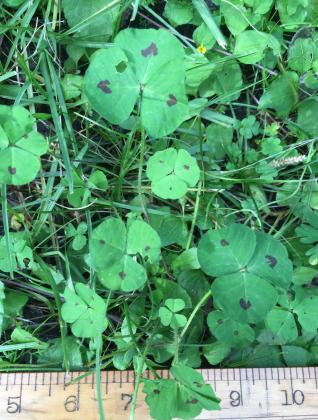Medicago arabica: Under the leaves, plant is scary looking
Medicago arabica, spotted medick or burclover, is easy to recognize because of the dark red blotch on each leaflet. The spot is anthocyanin, the same flavonoid that gives foods such as blueberries their color. But M. arabica is not edible. An annual, it is often found low to the ground mixed in with the grass. The plant, up to 2 ½ inches tall, has one leaf per node along a hairy stem that is often red-streaked. The one leaf appears to be three. It is trifoliate, having compound leaves with three leaflets that are usually wider than they are long. Each is about ⅔ inch.
There are stipules, leaf-like structures, along the stem that are incised, teeth-like. Their underside is hairy. The 1 to 5 yellow flowers are about ⅛ inch and turn into burs, seedpods, with 4 to 7 coils, each with double-sided spikes. They are green then brown. Seeds are viable up to 4 years. When you look under the leaves, after the flower fades, the plant is scary looking. It looks like a medieval weapon. When the plant dies those sharp burs remain hard, hidden in the grass. M. arabica contains sapo
M. arabica contains saponins, chemicals primarily found in plants that produce suds when added to water and agitated. For millennia people have used those plants for soap. They’ve also been used as a fish poison making it easy to catch the fish. There are many industrial and medicinal, particularly antibacterial, uses for saponins so there are many studies to quantify the amounts in plants and their effects, on living systems. You can follow this research about M. arabica and saponins at the National Institutes of Health, ncbi.nlm. nih.gov, Nature International Journal of Science, nature.com and many other sites.
The plant is native to the Mediterranean area and named for the old Persian city, Media. Persia is now Iran. Arabica is from the word Arab. The common name spotted medick describes the plant’s physical appearance. The burclover name comes from the sharp seedpods or burs even though it is not a true clover which is in the genus Trifolium. The genus Medicago, whose seeds are tiny beans, is in legume family, Fabaceae. Like other legumes, it fixes nitrogen. The plant is an excellent green manure and has been the subject of studies about its use as a cover crop in large-scale farming. A cover crop controls soil erosion and replenishes nutrients. It is planted after the primary cash crop has been harvested.
Studies are being done in an attempt to genetically modify the plant to remove the sharp spines. The Invasive Species Compendium, cabi.org, has an article, “Progress in development of spotted medics (Medicago arabica L. Huds.) for Mediterranean farming systems”. It reports on work being done in an attempt to reduce “pod spininess”. I think I speak for everyone who has ever stepped on one of those burs with bare feet or had to untangle them from a pet’s fur when I say, “We wish them luck”.


